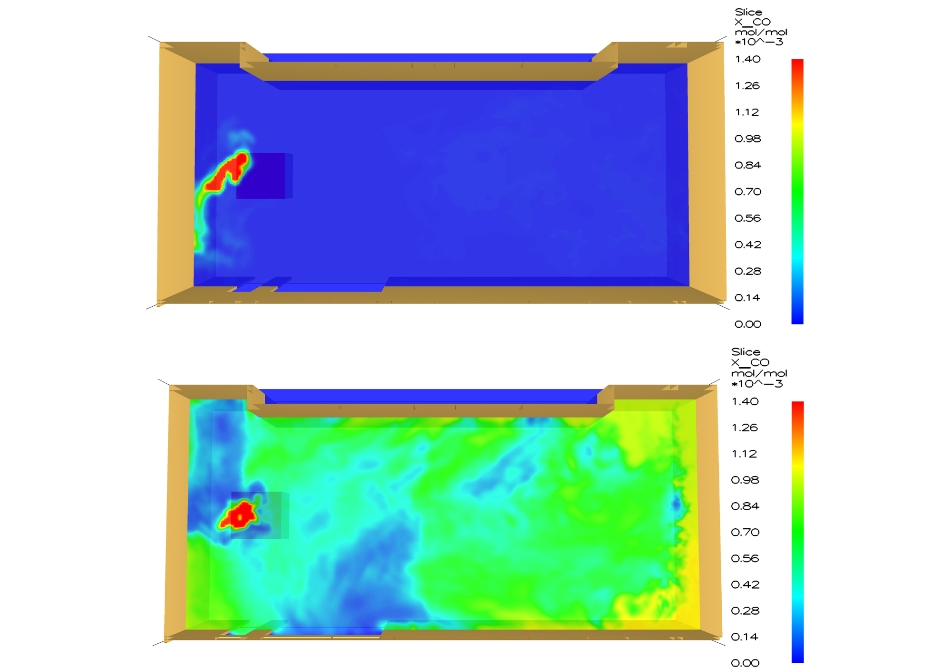May 6 2020
Solar chimneys are indispensable in green building design and can cut down energy costs by up to 50%. Now, a new study has demonstrated that these solar chimneys could also help save lives in the event of fire accidents in buildings.
 Modeling of carbon monoxide levels about 16 minutes after a fire breaks out shows the dramatic difference in CO with a solar chimney (top) and without (bottom). Image Credit: RMIT University.
Modeling of carbon monoxide levels about 16 minutes after a fire breaks out shows the dramatic difference in CO with a solar chimney (top) and without (bottom). Image Credit: RMIT University.
In a first-ever study, scientists have developed a solar chimney that has been optimized for both fire safety and energy saving, as part of the sustainable aspects of a modern building located in Melbourne, Australia.
Modeling demonstrated that the exclusively-designed solar chimney dramatically boosts the amount of time required by people to escape from the new building in the event of a fire—increasing the safe evacuation time from around two minutes to more than 14 minutes.
A solar chimney can be described as a passive solar heating and cooling system that controls a building’s temperature by harnessing natural ventilation.
It has been estimated that 19% of the global energy resources goes into heating, cooling, and ventilating the buildings. Therefore, retrofitting the solar chimneys to already existing structures and incorporating them into new buildings provide excellent potential for minimizing this huge environmental cost.
In the latest project, which was a collaboration between the City of Kingston and RMIT University, scientists developed a solar chimney to boost its efficiency for ventilating fresh air as well as for absorbing smoke from a building in the event of a fire.
According to researcher Dr Long Shi, while the environmental credentials of the solar chimneys are well established, their ability for enhancing fire safety has not been investigated yet.
In an emergency situation where every second counts, giving people more time to escape safely is critical. Our research demonstrates that solar chimneys offer powerful benefits for both people’s safety and the environment. Delivering on two important functions could boosts the already strong cost-effectiveness of this sustainable technology.
Dr Long Shi, Australian Research Council DECRA Fellow, RMIT University
Dr Shi continued, “We hope our findings will inspire more investment and development of solar chimneys in Australia, and around the world.”
Georgina Oxley, the Mayor of the City of Kingston, informed that the Council was happy to be a part of this revolutionary project.
“Creating new and innovative ways of reducing energy consumption in our building design is something that is a priority for Council,” stated Oxley.
“The solar-chimney that has been installed at the new state-of-the-art Mentone Reserve Pavilion not only allows us to harness clean green energy to heat and cool the building, helping Council achieve its environmental goals, but it also has the potential to save lives in the event of a fire. This is a truly remarkable design,” Oxley added.
Although estimates around the six times increase in the safe evacuation time were specific to the contemporary building, an earlier study conducted by the researchers from RMIT University’s School of Engineering has substantiated that solar chimneys can effectively accomplish both functions—that is, smoke exhaustion and ventilation.
Hot Air Rises: How a Solar Chimney Works
The passive design method behind solar chimneys is based on the popular principle that hot air constantly increases. Contemporary solar chimneys often comprise a glass wall next to a black-painted wall to boost the absorption of solar radiation. Vents, provided at the top and bottom of the solar chimneys, regulate the airflow both in and out of the chimney for cooling or heating purposes.
When the Sun heats the chimney, the air inside this chimney is also heated up. This hot air subsequently rises and is vented through the top of the solar chimney, which sucks in more air at the bottom and drives the ventilation via a building to cool it down naturally. When the outdoor temperature is cold, the solar chimney can be closed so that the absorbed heat can be directed back into the building to keep it warm.
This clever yet simple idea makes it comparatively cheap to retrofit, as it does not add any major additional cost to a new building while reducing energy consumption.
Reducing Smoke, Increasing Safety
In the event of a fire, the same kind of principle—that is, hot air rises—allows the solar chimney to absorb smoke from the building.
Minimal smoke means reduced carbon monoxide, lower temperatures, and better visibility—all of which can play a role in extending the amount of time that would allow people to evacuate safely.
To figure out the exact amount of the evacuation time that could be delivered by a solar chimney for a particular building, one needs to model for that precise design, added Shi.
This will differ from building to building, but we know that any extra time is precious and improves fire safety, which could ultimately help to save lives.
Dr Long Shi, Australian Research Council DECRA Fellow, RMIT University
The latest study provides a technical guide for improving the engineering and design of solar chimneys in actual buildings, to extend their use over the two functions.
The study titled, “Solar chimney for a real building considering both functions of energy saving and fire safety – a case study,” was published in the Energy and Buildings journal. Co-authors include Anthony Ziem, Jie Li, Professor Kevin Zhang, and Professor Sujeeva Setunge.
How a solar chimney can boost fire safety | RMIT University
Video Credit: RMIT University.
Journal Reference:
Shi, L., et al. (2020) Solar Chimney for a Real Building Considering Both Energy-Saving and Fire Safety – A Case Study. Energy and Buildings. doi.org/10.1016/j.enbuild.2020.110016.